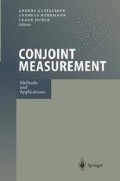Abstract
It is clear that conjoint analysis has had a substantial impact upon research practice (Wittink and Cattin 1989; Wittink, Vriens and Burhenne 1994). Conjoint analysis has evolved, and along with that evolution has been a gradual shift in the types of responses collected, from rankings to ratings to choices.
Access this chapter
Tax calculation will be finalised at checkout
Purchases are for personal use only
Preview
Unable to display preview. Download preview PDF.
References
Ben-Akiva, M. and Lerman, S. (1985), Discrete Choice Analysis: Theory and Application to Travel Demand,Cambridge.
Elrod, T. and Chrzan, K. (1994), Partial Profile Conjoint Analysis: a Choice-Based Approach for handling large Numbers of Attributes, Faculty of Business, University of Alberta, Canada.
Elrod, T. and Chrzan, K. (1995), Choice-based Approach for large Numbers of attributes, Marketing News, 29, 20–30.
Elrod, T., Louviere, J. and Davey, K.S. (1992), An empirical Comparison of ratings-based and choice-based Conjoint Models, Journal of Marketing Research, 24, 368–377.
McCullagh, P. (1980), Regression Models for Ordinal Data, with Discussion, Journal of the Royal Statistical Society, 42, 109–142.
Swait, J. and Louviere, J. (1993), The role of the Scale Parameter in the Estimation and Comparison of Multinomial Logit Models, Journal of Marketing Research, 30, 305–314.
Vriens, M., Oppewal, H. and Wedel, M. (1998), Ratings-based versus Choice-Based Latent Class Conjoint Models–an empirical Comparison, Journal of the Market Research Society, 40, 237–248.
Wittink, D.R., and Cattin, P. (1989), Commercial Use of Conjoint Analysis: An Update, Journal of Marketing, 53, 91–96.
Wittink, D.R.,Viens, M. and Burhenne, W. (1994), Commercial Use of Conjoint Analysis in Europe: Results and critical Reflections, International Journal of Research in Marketing, 11, 41–52.
Rights and permissions
Copyright information
© 2000 Springer-Verlag Berlin Heidelberg
About this chapter
Cite this chapter
Elrod, T., Chrzan, K. (2000). The Value of Extent-of-Preference Information in Choice-based Conjoint Analysis. In: Conjoint Measurement. Springer, Berlin, Heidelberg. https://doi.org/10.1007/978-3-662-06395-8_9
Download citation
DOI: https://doi.org/10.1007/978-3-662-06395-8_9
Publisher Name: Springer, Berlin, Heidelberg
Print ISBN: 978-3-662-06397-2
Online ISBN: 978-3-662-06395-8
eBook Packages: Springer Book Archive

